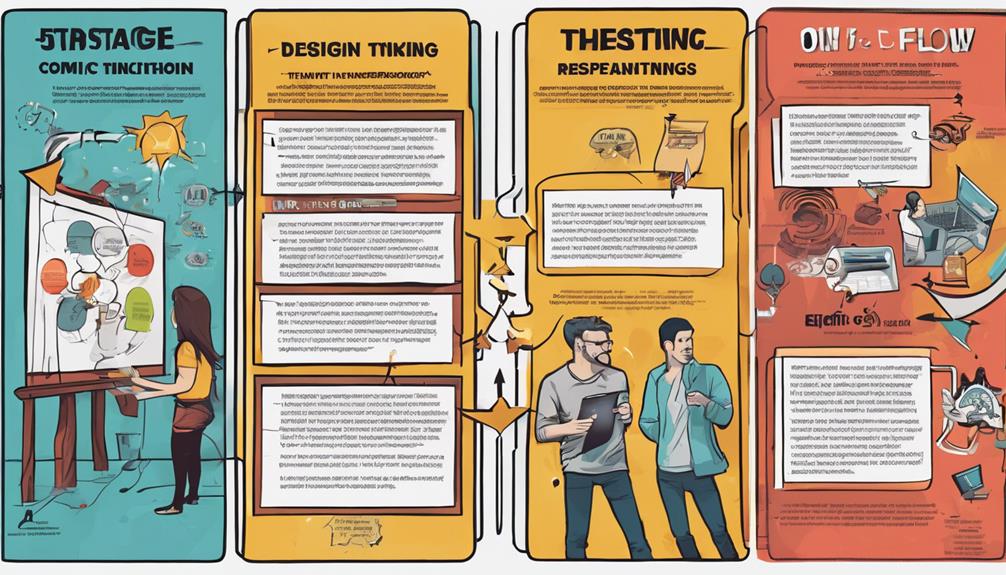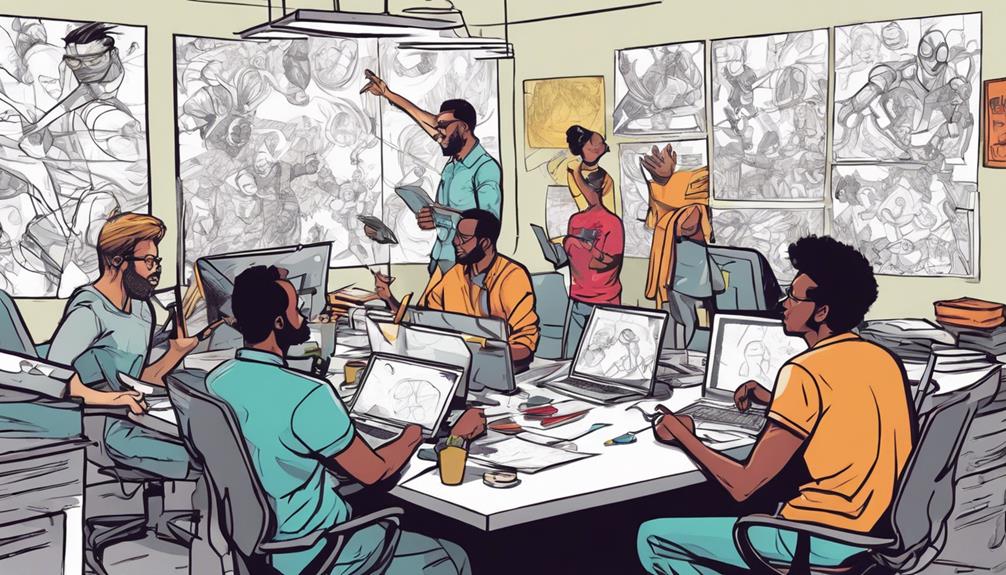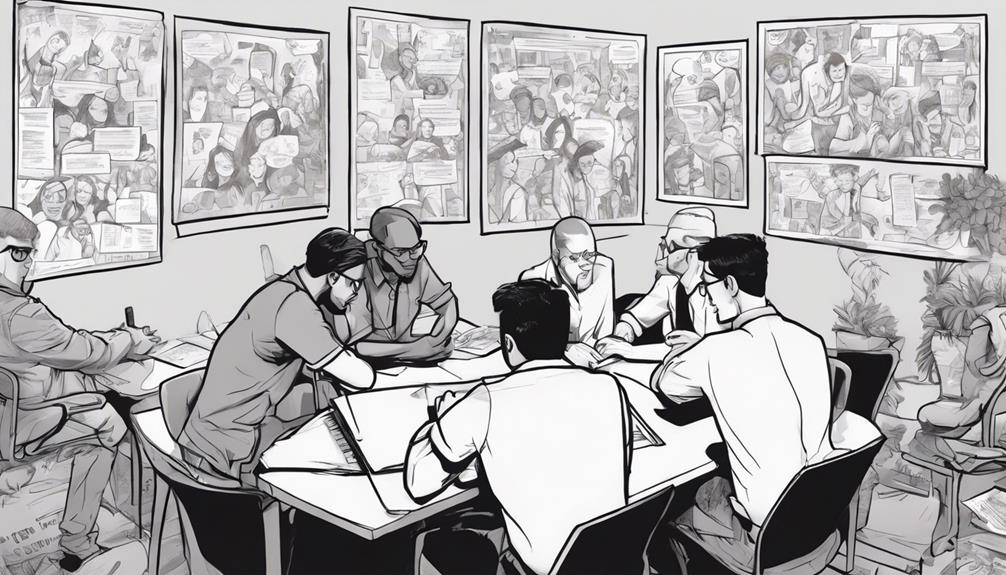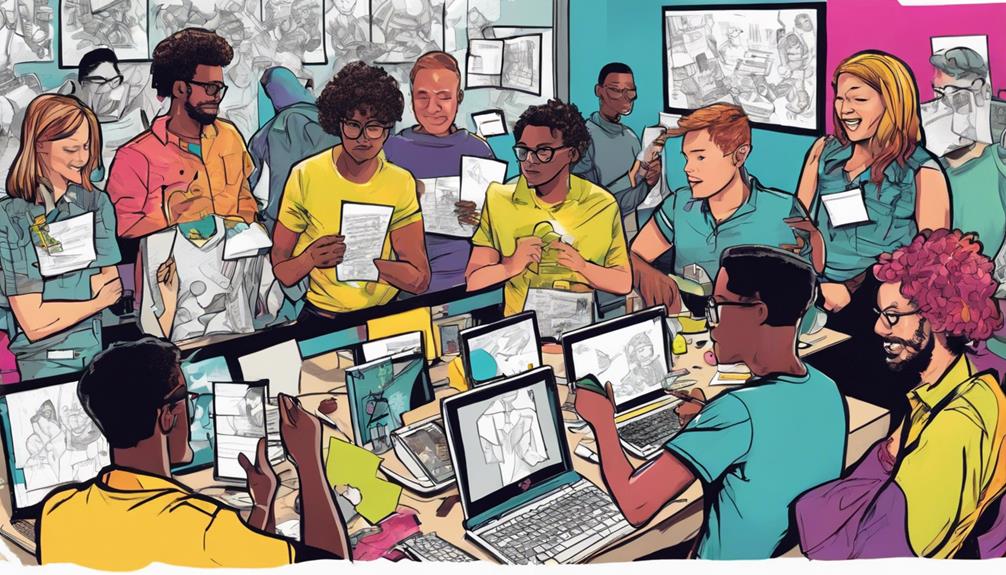Express your creativity and problem-solving skills with a design thinking workshop! Engage in hands-on activities fostering empathy and ideation for innovative solutions. Prototype your ideas, foster a culture of experimentation, and witness your ideas come to fruition. Explore enhanced efficiency, customer retention, and team collaboration. Planning necessities guarantee a productive session in a creative environment with a structured agenda. Post-workshop actions polish ideas and create validated prototypes for ongoing enhancement. Your adventure begins here, where user-centered solutions and immersive roleplay scenarios are ready to drive your transformative design thinking journey.
Key Takeaways
- Engage in hands-on activities for ideation and prototyping.
- Foster empathy for user perspectives to drive innovative solutions.
- Utilize brainstorming techniques for creative problem-solving.
- Emphasize a human-centered focus for user-centric outcomes.
- Promote a culture of experimentation and learning from failures.
Workshop Basics
Design Thinking workshops serve as immersive sessions where participants engage in hands-on activities to navigate through the Design Thinking process. These workshops focus on fostering empathy by encouraging participants to understand the needs and perspectives of the users they're designing for.
Through ideation, participants brainstorm and generate creative solutions to address the identified problems. Prototyping allows teams to bring their ideas to life in a tangible form, enabling them to test and iterate on their concepts. By emphasizing testing, Design Thinking workshops promote a culture of experimentation and learning from failures to refine solutions effectively.
Moreover, collaboration plays an essential role in these workshops, as diverse teams work together to combine their unique skills and insights. Problem-solving is at the core of Design Thinking, with participants encouraged to tackle challenges creatively and innovatively.
Whether conducted in person or remotely, these workshops provide a structured framework for teams to approach complex problems with a human-centered focus.
Benefits and Impact
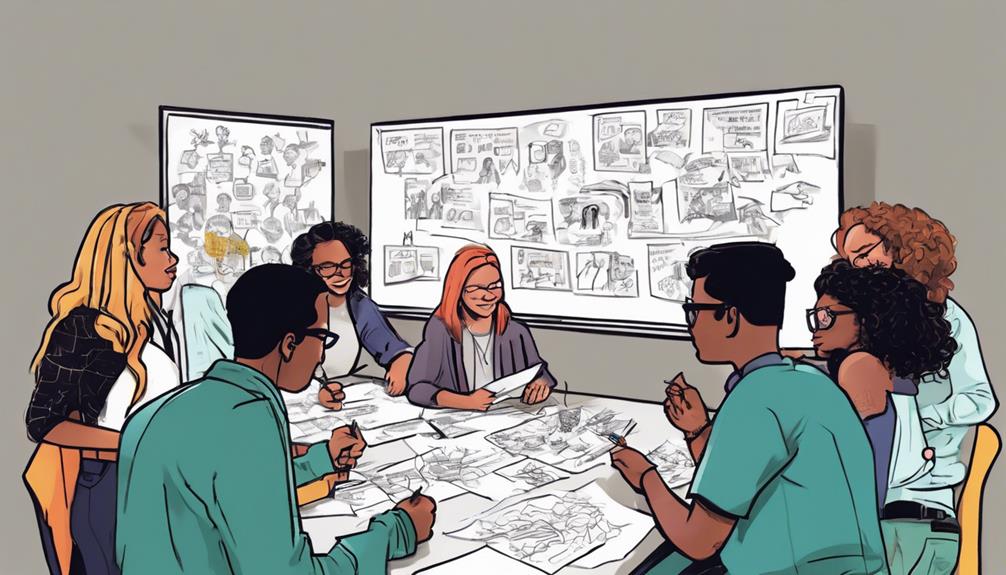
Experience significant benefits in your organization by participating in Design Thinking workshops. These workshops are not just about generating ideas; they are a strategic approach that can revolutionize how your team operates. By focusing on user needs and employing human-centered design, Design Thinking workshops lead to a myriad of advantages. Check out the table below to see the impact these workshops can have on your organization:
| Benefits | Impact |
|---|---|
| Faster Time-to-Market | 80% increase |
| Higher Customer Retention | 56% increase |
| More Innovative Ideas | 218% increase |
| Improved Team Collaboration | 47% increase |
Through ideation techniques and incorporating Design Thinking principles, these workshops not only boost creativity but also enhance teamwork effectiveness. Moreover, organizations embracing Design Thinking gain a competitive edge in the market, ultimately leading to increased customer retention rates. By implementing Design Thinking workshops, your organization can access a world of possibilities and stay ahead of the competition.
Planning Essentials
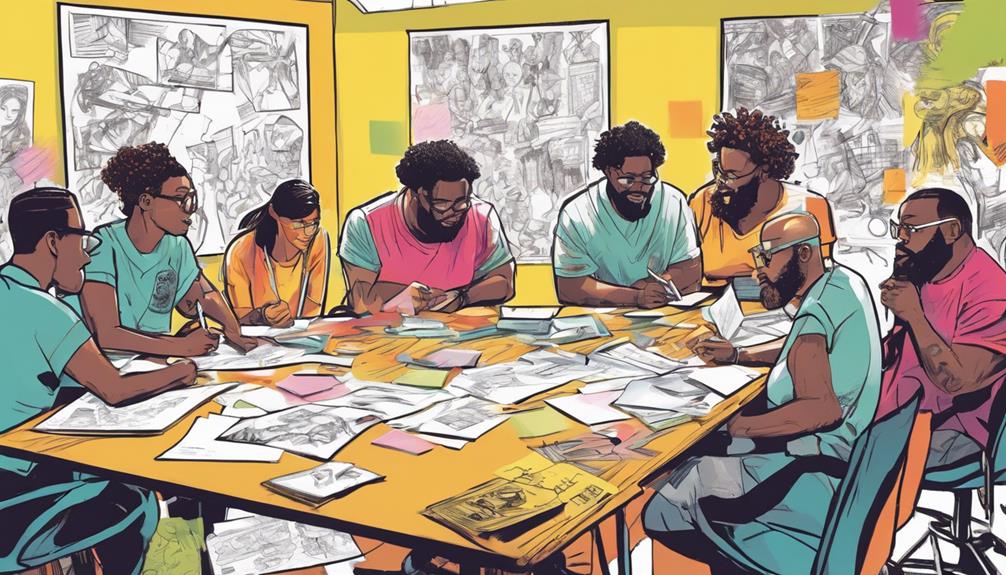
To guarantee the success of your Design Thinking workshop, careful planning is essential, starting with scoping out the challenge and setting clear objectives.
When planning your workshop, consider the following key essentials:
- Location: Choose a space that fosters creativity and collaboration, ensuring participants feel inspired and motivated.
- Materials: Gather all necessary supplies beforehand, from sticky notes to prototyping tools, to facilitate a smooth and productive workshop.
- Participants: Engage your attendees from the start by clearly communicating the workshop's purpose and encouraging active participation throughout.
- Agenda: Develop a well-structured agenda that guides participants through the Design Thinking process, keeping them focused on generating innovative solutions.
Detailed Workshop Steps
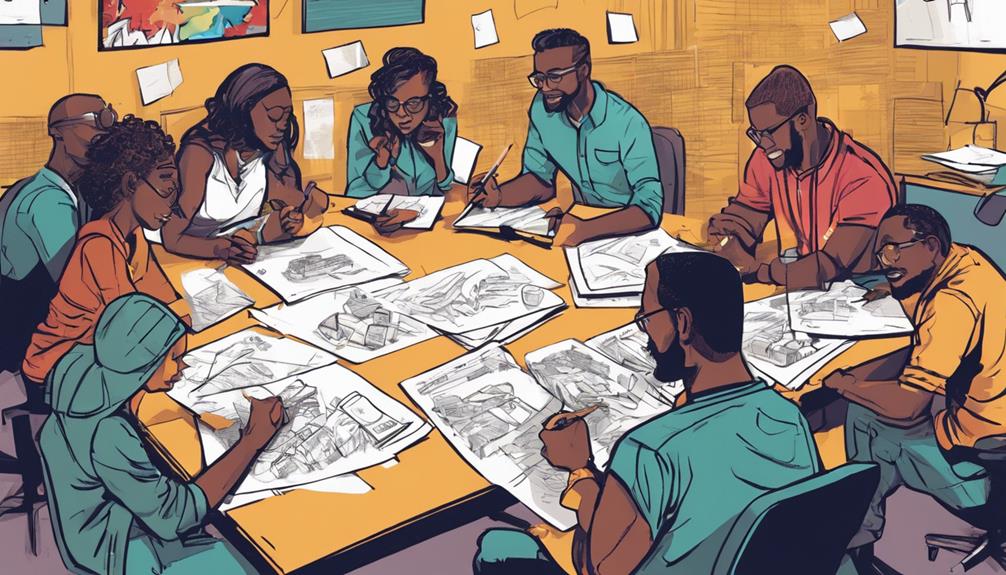
Begin by outlining the sequence of activities that will guide participants through the Design Thinking workshop process, ensuring a structured and productive session.
The workshop starts with an introduction to set the stage, followed by an ice-breaker to foster collaboration.
Empathy building helps in understanding user needs, leading to problem definition for focused ideation.
User journey mapping enhances empathy and aids in creating user-centric solutions.
Moving forward, prototyping brings ideas to life, followed by testing to gather feedback and refine solutions.
The final step involves debriefing to reflect on the process, collect insights, and plan next steps for implementation.
Each step in the workshop is crucial for nurturing innovation and developing solutions that address user needs effectively.
Post-Workshop Actions
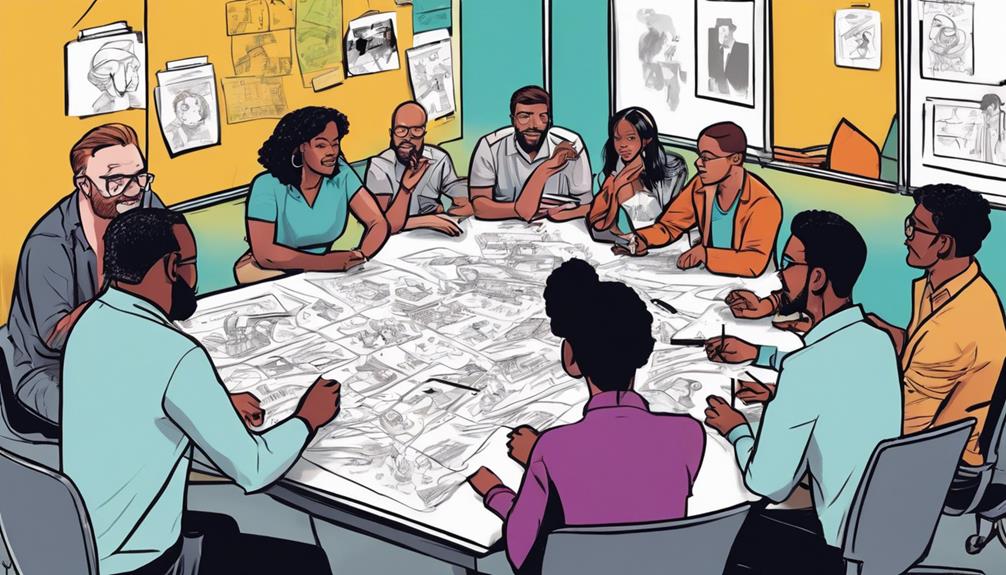
Now that the workshop has concluded, it's time to put your insights into action.
Analyze the outcomes to pinpoint successful ideas and areas for improvement.
Refine and develop these ideas further based on feedback and testing results.
Analyzing Workshop Outcomes
Upon completion of the Design Thinking workshop, you'll explore analyzing the outcomes to determine the most viable solutions for further development. This process involves reviewing the ideas generated, prototypes created, and feedback received during the workshop.
You'll assess the feasibility, viability, and desirability of the proposed solutions to align them with user needs and business objectives. The next steps include prioritizing the ideas based on testing results to identify the most promising concepts for refinement and iteration.
- Evaluate Ideas: Review the generated ideas against user needs and business goals.
- Assess Prototypes: Analyze the prototypes created for feasibility and potential impact.
- Consider Feedback: Incorporate feedback received to enhance the solutions.
- Prioritize Solutions: Rank the ideas based on testing results to focus on the most viable options for further development.
Refining Generated Ideas
After analyzing workshop outcomes and feedback, refine the generated ideas to enhance feasibility and effectiveness. By conducting thorough feedback analysis, you can pinpoint areas for improvement and prioritize solutions that align best with user needs.
Develop prototypes based on testing results to guarantee that the solutions are viable and address the identified challenges effectively. Implement the most promising solutions into the product or process to drive innovation and continuous improvement.
It's essential to take the insights gathered from the workshop and use them to refine generated ideas further. This iterative process of idea refinement will help optimize the solutions and increase their chances of success.
Consider organizing follow-up workshops or training sessions to sustain the momentum of innovation and ensure that the generated ideas remain aligned with user requirements. Remember, continuous improvement is necessary post-workshop to drive innovation and deliver impactful results.
Developing Tested Prototypes
How can you effectively shift from refining generated ideas to developing tested prototypes post-Design Thinking workshop?
Once you have identified the most promising solutions, it's important to further develop prototypes based on feedback and testing results to verify they effectively meet user needs.
To achieve this, consider the following steps:
- Incorporate User Feedback: Gather insights from users to refine ideas and verify prototypes address their specific needs.
- Test Prototypes: Conduct thorough testing to validate the effectiveness of the solutions in real-world scenarios.
- Implement Effective Solutions: Integrate the most viable prototypes into the product or process to drive innovation and improvement.
- Focus on Continuous Improvement: Organize follow-up workshops or training sessions to sustain the momentum of innovation and problem-solving, verifying that the final solutions are user-centered and aligned with business goals.
Design Thinking Techniques

Design Thinking workshops utilize a variety of techniques, including Empathy Mapping, Brainstorming, Rapid Prototyping, the Five Whys, and SCAMPER, to foster creativity and innovation in problem-solving processes.
| Techniques | Description |
|---|---|
| Empathy Mapping | Understanding user needs and motivations visually to drive innovation in problem-solving processes. |
| Brainstorming | Collaborative idea generation in an open environment to explore a wide range of solutions quickly. |
| Rapid Prototyping | Efficient visualization and iteration of ideas to test and validate concepts swiftly in Design Thinking workshops. |
| The Five Whys | Uncovering root problems by repeatedly asking 'why,' delving deeper into issues to find effective solutions. |
| SCAMPER | Employing seven creative categories to inspire innovative ideas and solutions within the Design Thinking framework. |
These techniques collectively enhance the design process by focusing on user needs, encouraging idea generation, and promoting efficient problem-solving to generate innovative solutions.
Journey Mapping Insights
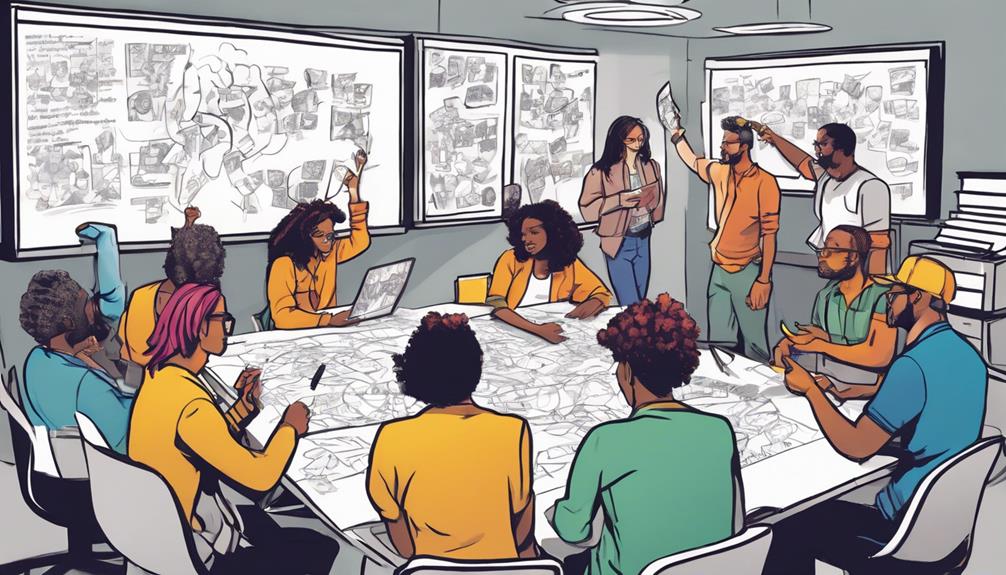
You can gain valuable insights through journey mapping by visualizing user experiences, pinpointing pain points, and analyzing stages of interaction.
By creating specific user personas and mapping their journeys, you can better understand their interactions with your product or service.
Breaking down the journey into stages allows for targeted analysis, revealing areas for enhancement and customer satisfaction.
User Experience Visualization
Regularly used in design workshops, journey mapping provides valuable insights into the user experience with a product or service. By illustrating the user journey, empathy maps, user personas, and pain points are identified to create a thorough understanding of user interactions.
Breaking down the journey into distinct stages allows for a detailed analysis, revealing opportunities for enhancing customer satisfaction and improving the overall user experience. In design thinking workshops, journey mapping serves as a powerful design tool to capture user needs, preferences, and pain points in a visual and actionable format.
- Illustrating the user journey evokes empathy and understanding for the user's experience.
- Identifying specific user personas helps in creating a more personalized and targeted approach.
- Highlighting pain points brings attention to areas that need improvement for a better user experience.
- Mapping user interactions provides insights into how users engage with the product or service, guiding design decisions.
Pain Points Identification
By visualizing the user experience through journey mapping, identifying pain points becomes an important step in enhancing product or service design. Design Thinking emphasizes understanding the user journey to create innovative solutions.
During the journey mapping process, the team analyzes specific user personas and their interactions with the product or service. This breakdown helps pinpoint pain points, which are key areas for improvement. By identifying these pain points, designers can focus on enhancing the user experience at critical stages.
Journey mapping divides the user experience into stages, allowing for a detailed examination of where problems occur. Understanding these pain points is vital as it leads to the development of targeted solutions that address users' needs effectively.
Through this approach, Design Thinking enables teams to transform ideas into impactful changes that enhance the overall user experience.
Stage-Based Analysis
Through stage-based analysis in journey mapping, teams gain valuable insights into user interactions with the product or service, revealing critical areas for enhancement. By breaking down the user journey into distinct stages, design thinking workshops can effectively identify pain points and areas for improvement. This detailed analysis allows teams to understand specific user personas and their experiences, leading to a more empathetic approach to product/service design.
Emotions can run high during this process:
- Frustration: Uncovering pain points can be exasperating but essential for growth.
- Inspiration: Discovering areas for improvement can spark innovative solutions.
- Empathy: Understanding user interactions fosters compassion towards customer needs.
- Motivation: Identifying opportunities for enhancement motivates teams to aim for customer satisfaction.
Roleplay in Action
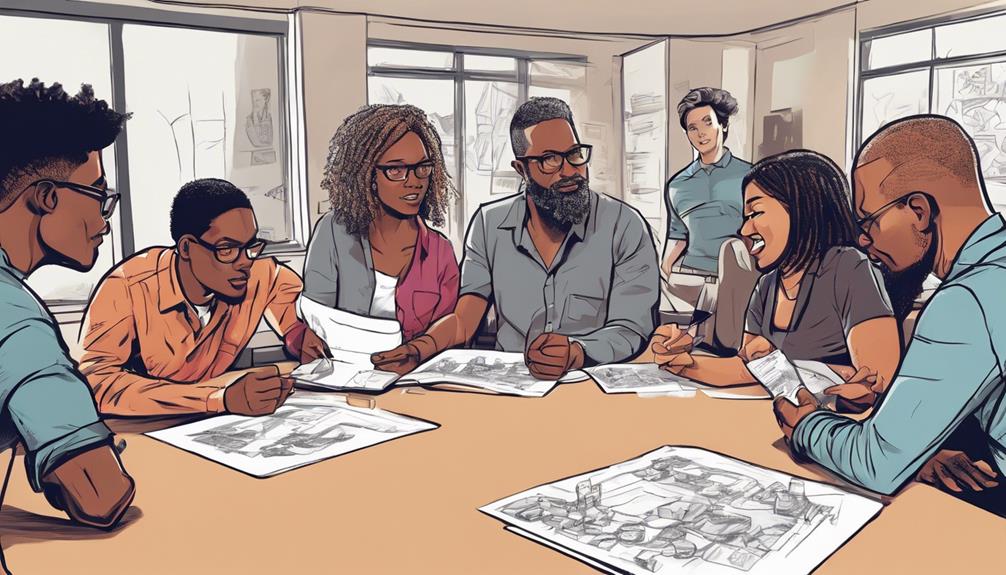
Engage your team members in immersive roleplay scenarios during design thinking workshops to enhance understanding of user needs and foster creative problem-solving. Roleplay in these workshops involves acting out user scenarios to explore potential solutions effectively.
By immersing participants in real-life situations, roleplay helps uncover user needs and obstacles that mightn't be apparent initially. Through taking on different roles like users or customer service representatives, participants gain valuable insights into the challenges faced by different stakeholders. This firsthand experience encourages creative thinking and empathy by allowing individuals to see problems from various perspectives.
Additionally, post-session discussions following roleplay sessions are essential for delving deeper into the discoveries made and identifying potential innovative solutions. Roleplay is a powerful tool in design thinking workshops for enhancing collaboration, understanding user needs, and generating out-of-the-box ideas.
SEI Customer-Centric Innovation
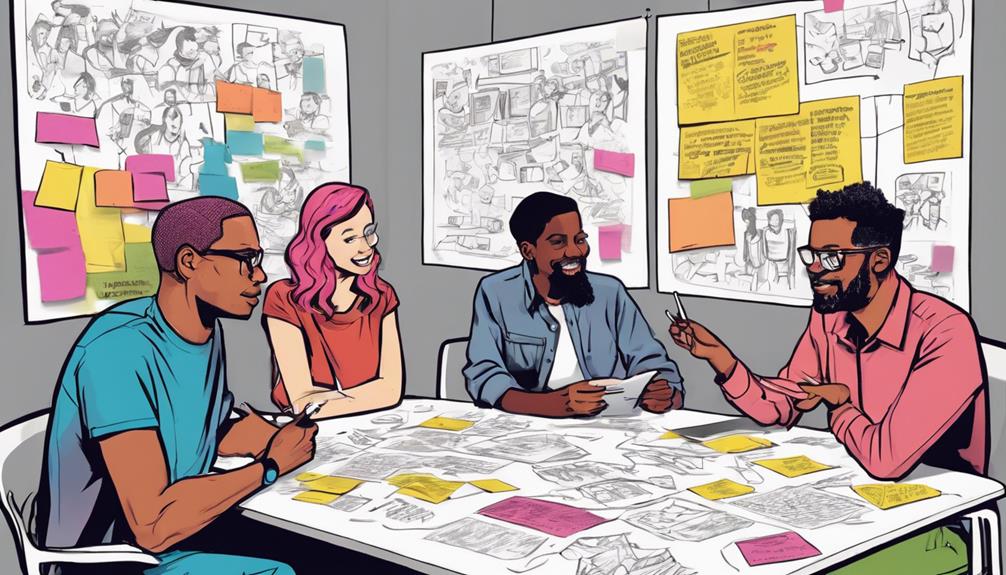
SEI excels in customer-centric innovation by leveraging design thinking methodologies to tailor innovative solutions to end-users' needs. Their approach focuses on understanding customer needs and delivering successful product launches. Here's why SEI's customer-centric innovation stands out:
- Experienced Consultants: SEI offers seasoned consultants who drive the creation of innovative solutions customized to end-users, ensuring a profound understanding of their requirements.
- Comprehensive Leadership: SEI provides strong leadership throughout the design thinking process, guiding teams towards customer-centric solutions that resonate with end-users.
- On-Site Support: With on-site support, SEI guarantees that the implementation of innovative solutions is seamless and aligned with end-users' expectations.
- Agile and Technology-Agnostic Approaches: By embracing Agile methodologies and technology-agnostic solutions, SEI creates positive customer experiences through flexible and adaptable innovation processes.
Transformative Design Thinking Process

Let's explore the essential points of ideation techniques and user-centric solutions within the transformative Design Thinking process.
These aspects focus on fostering creativity, challenging assumptions, and developing innovative solutions that meet user needs effectively.
Ideation Techniques
During the ideation phase of a design thinking workshop, various techniques are employed to foster creative problem-solving and idea generation. Techniques such as brainstorming, SCAMPER, mind mapping, reverse thinking, and the random word technique are utilized.
- Brainstorming: Encourages rapid idea generation in a collaborative environment.
- SCAMPER Technique: Helps in creative problem-solving by substituting, combining, adapting, modifying, putting to other uses, eliminating, or reversing ideas.
- Mind Mapping: Enhances creativity by visually organizing and exploring ideas in a non-linear format.
- Reverse Thinking: Leads to out-of-the-box solutions by challenging conventional assumptions through problem statement reversal.
These ideation techniques create a dynamic and engaging space where diverse perspectives converge, sparking innovative solutions. By utilizing these methods, you can break free from traditional thought patterns, fostering a culture of creativity and exploration that drives forward-thinking ideas.
User-Centric Solutions
In crafting user-centric solutions within the transformative design thinking process, understanding user needs, motivations, and emotions takes center stage. Design Thinking workshops emphasize empathy, ensuring that products or services resonate deeply with end-users.
By challenging assumptions and defining clear problem statements, innovative solutions that truly address user needs emerge. Prototyping and testing strategies play pivotal roles in refining ideas based on user feedback, guaranteeing that final solutions effectively meet user expectations.
Collaborative efforts in Design Thinking workshops foster a creative environment where teams work together to develop transformative products or services that enhance user experiences. By incorporating user feedback and iterating on designs, Design Thinking workshops empower teams to create solutions that not only meet but exceed user expectations, ultimately leading to impactful and user-centered outcomes.
Frequently Asked Questions
What to Do in a Design Thinking Workshop?
In a design thinking workshop, you empathize with users, brainstorm for innovative solutions, create rapid prototypes for feedback, visualize user journeys, and roleplay scenarios. Engage deeply, ideate freely, prototype swiftly, map journeys, and roleplay interactions.
What Is a Workshop Process in Design Thinking?
A workshop process in Design Thinking involves empathy building, ideation, prototyping, and testing to solve problems creatively. Collaborate, innovate, and focus on user needs to generate actionable solutions. Embrace structured creativity for real-world challenges.
What Are the Benefits of Design Thinking Workshop?
Access the power of Design Thinking workshops – they fast-track innovation, foster creativity, and enhance problem-solving skills. Embrace user-centric solutions, teamwork, and a competitive edge. Stay ahead in the market with groundbreaking ideas.
What Is the Purpose of a Design Workshop?
The purpose of a design workshop is to foster creativity, collaboration, and innovation among participants. You engage in hands-on activities that help you understand user needs, generate ideas, and prototype solutions to address specific challenges effectively.
Conclusion
Ready to elevate your ideas to the next level?
With a design thinking workshop, you can transform your thinking and drive innovation in your organization.
So, why wait?
Immerse yourself in the transformative process of design thinking and unleash the potential of your ideas today!

